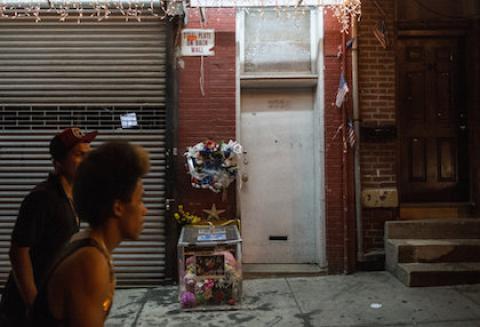Like so many New York neighborhoods, Tompkinsville on Staten Island can almost seem like an island of its own. A half-mile walk from the St. George Ferry Terminal, the neighborhood has a park, which is hardly more than a traffic triangle with a few trees and a small fountain. Mothers with baby strollers and small children linger just outside it. There’s a Dominican restaurant on a corner and a taxi company up the block, next to a beauty supply shop with a box outside it containing plastic flowers, a makeshift memorial.
Eric Garner died after being put in a chokehold by the police on the sidewalk outside the shop a year ago this Friday.
The battle over his death wasn’t only about policing, but about public space. The civil rights movement of the 1960s was played out largely as a struggle for equality at schools, bus stops, swimming pools, churches, sidewalks and luncheonette counters. Some things haven’t changed.
“The presumption is that blacks are suspect just simply by being in public places,” is how Mario Gooden, a principal at Huff + Gooden Architects, an African-American-run firm based in New York, sees it. Mr. Gooden cited the case of Tamir Rice, the 12-year-old boy playing with a toy gun in a park in Cleveland, shot dead by a police officer less than two seconds after they arrived at the scene.
Once, Tompkinsville, on the north end of Staten Island, was prosperous. But the Staten Island Expressway, an urban renewal project sometimes locally referred to as the Mason-Dixon line, cleaved the two ends of the island. Completed during the early 1960s, it drew business away from the north to the center, and like other highways built smack through cities, became more than just a physical barrier.
The roadway exacerbated racial and economic divides, separating white and black. It was largely voters on the south end of the island who elected Daniel M. Donovan Jr. The former district attorney, and now congressman, Mr. Donovan presided over the grand jury that failed to indict the police officer involved in the death of Mr. Garner.
“You can trace a lot of what’s happening back to urban renewal,” said Vishaan Chakrabarti, a partner at SHoP Architects in New York and author of “A Country of Cities.”
For Mr. Chakrabarti, the latest spate of killings of unarmed African-Americans by the police and others speaks to the legacy of slum clearance, federal home mortgage interest deductions, redlining, oil subsidies and highway construction.
Urban renewal conspired to promote white flight, encouraged gated developments, like the one in Sanford, Fla., where Trayvon Martin was killed, and destroyed traditional African-American neighborhoods, replacing them with public housing complexes that were left to rot. Last fall, Akai Gurley was shot dead by a policeman in the unlighted stairwell of a dilapidated project in East New York.
Reinhold Martin, an architecture professor at Columbia, puts it differently. “You can blame urban renewal, suburbs, the breakdown of inner cities,” he told me. “But in the end we’re really talking about real estate, which is about borders.”
“It’s primal,” he added. “Real estate involves thresholds, creating lines that should not be crossed, places that are off limits to certain people. African-Americans are supposed to be invisible in public spaces. The challenge for African-Americans is to gain access to these places, to infrastructure and amenities, so they can be seen and heard.”
For evidence of how important such shared spaces can be, one needs only to look at what Mr. Chakrabarti calls the “virtual commons,” meaning Twitter, Instagram, Facebook, YouTube and other forms of social media that broadcast the deaths of Mr. Garner, Mr. Rice and others. Not so long ago, civil libertarian concerns about surveillance focused on the proliferation of security cameras. Today, the inevitability of smartphones has brought with it changing expectations of privacy in public and the power to bear witness. Smartphones update the urbanist Jane Jacobs’s concept of “eyes on the street,” which helped neighbors police city sidewalks — or now, as in Mr. Garner’s case, help police the police.
Of course, demanding justice and delivering it are clearly different things. The virtual commons can’t do the job of a special prosecutor or overcome segregated voting districts or replace the power of real bodies in real space.
Nor can it substitute for parks, streets and squares as safe and welcoming hubs for neighborhoods.
But it can sustain vigilance and insure that what happened in Cleveland in November or one year ago on a sidewalk outside a beauty parlor on Staten Island will not go unnoticed or unheeded.
[Michael Kimmelman is the architecture critic for The New York Times. He has written on issues of public housing, public space, infrastructure, community development and social responsibility. In March 2014, he was awarded the Brendan Gill Prize for his "insightful candor and continuous scrutiny of New York's architectural environment." ]


Spread the word